The question isn’t when is tele going to resume growth, the question is, as the torch of tele passion is picked up, will it be via a retro return to leather, pins and waxless metal-edged skis? Instead, perhaps a stubborn refusal to abandon the duckbill and free pivoting cable bindings. Or, follow the trend unfolding, a slow embrace of NTN.
Scarpa’s Kim Miller, President of Scarpa USA confirmed it, “No question, NTN is outselling 75mm now. It looks like the future of tele, especially now that there are other [binding] choices.”
The US distributor of Crispi and co-owner of telemarkdown.com, Erik Fey agrees, saying, “The Evo and Shiver, the NTN models, are definitely outselling 75mm boots this season.”
The variety of bindings to chose from is part of the lure. It’s no longer just Rottefella’s Freeride. Their Freedom has taken the lead with a binding that is lighter, easier to operate, engages quickly with soul and it has a nice, lightly tensioned tour mode. If you spend more than 50% of your ski days yo-yoing, this binding rocks. Plus there are other options to chose from now although they don’t use the patented 2nd heel. More importantly there’s another on the way that does.
Indeed, the only new telemark binding at the recent Outdoor Retailer Winter trade show was a prototype NTN binding unveiled by 22 Designs to announce they had licensed the use of the 2nd heel from Rottefella. The nameless duckbutt binding demonstrated true step-in functionality, no release, adjustable power and a free-pivoting tour mode like the son of Hammerhead, Axl.Meanwhile, in the duckbill pond, Axl and Switchback continue to sell healthy numbers, but not 10,000 strong numbers. Maybe combined, but no one is sharing sales secrets.
Those are decent numbers, but not the kind that instill excitement, and in turn, growth. It’s hard to be profitable in business with no growth.
Interest in telemarking as a cult tribe of skiers won’t die because of the enthusiasm it demands from its players. In spite of a steady reduction in participation, improvements to telemark bindings continue to be developed. However, it is clear interest won’t grow again until tele boots are at least on par with what is available with AT boots in terms of downhill and uphill performance. In case you forgot, it was the quest to be on par with alpine for downhill prowess that led to telemark’s popularity in the 90s.However, it wasn’t all about downhill skiing. It was also about the lure of the backcountry that had captured the imagination of skiers thanks to the writing of people like Steve Barnett, Doug Robinson, Tom Carter and Alan Bard, and Rick Borkevec and films like the Blizzard of Aaahs. When Terminator visited earth in 1993 it promised the control of an alpine boot via a plastic shell, with the freedom of a free heel. The result was the American backcountry scene exploded..
Unfortunately the control PTBs promised inevitably sacrificed the freedom of the free heel and with it telemark’s backcountry appeal. Bindings offered a free-pivot to save the day, but for many it was too little too late. Telemark binding makers continue to tinker, but there’s little more to be done with 75mm, and any radical improvements to NTN need a complimentary improvement in boots.While Kim Miller admits it is time for some improvements to Scarpa’s line of telemark boots, he also adds, “when binding makers settle down a bit then we’ll reassess what is going on and apply it. We don’t want to be designing our boots to a moving target and we’re very interested in what 22 Designs has up their sleeve.”
I’ll admit, I don’t know the numbers and how many it takes to motivate a boot company to modify or built a set of molds.
There may not be 2-million active telemark skiers in America today, but I’m confident there are still at least 200,000. At $500 per pair of boots that’s a potential $100-million dollar market. Even if only half upgrade, that’s still a $50-million market.Maybe I have my math wrong, so let’s look at it from telemark’s greatest attribute, enthusiasm. Whatever the market was back when the Terminator was developed, it was a fraction of what the customer base is now. I asked Paul Parker, author of Free Heel Skiing if he knew the size of the tele market in the late 80s and he put it at 15k-20k strong, but also admitted that was a “wild ass guess.” My recollections of conversations with other boot makers suggests that number was in the ballpark, but nobody really knows. And yet Scarpa, with the encouragement of Black Diamond, developed the molds for a plastic telemark boot based on what? Certainly not the size of the existing market. It had to have been on their faith that if they built the right product, the customers would come and the market would grow.
By comparison today there is already a market large enough to justify development. Though AT has supplanted tele as the dominant form of backcountry skiing, a good portion of that shift is because telemark equipment failed to keep up with meeting those criteria. To restore interest, telemark must at least offer parity for touring efficiency. The best first step is to improve the cuff range of motion and the best chance for that to happen is for Scarpa to step up, again, and fix the shortcomings in telemark boots.If it seems like I’m holding Scarpa accountable over other brands I’ll admit I am for a number of reasons. First, they have demonstrated with their AT boot line that they already understand and own the technology available that telemarkers are lusting after. Secondly, they are the dominant telemark boot brand, generally due to superior products, but also to simply providing a product others have lost interest in. Which is due, largely to their leadership role, not only in the development of plastic telemark boots, but also in spearheading and managing the introduction of NTN in the marketplace.
Now I know I’m asking a lot here, and it isn’t my money being put on the table. However, Scarpa has shown in the past that they not only have the ca-hones to lead where others follow, but they also have good instincts on what needs to be done. So I’m both pleading and provoking Scarpa to stop waiting for the tele market to grow and provide a reason for it to grow — a tele boot with walk mobility like Maestrale, Dynafit inserts for touring efficiency, their trademark smooth flexing sole, and if you could shave half a pound per boot while you’re at it without compromising anything else, what telemark skier in their right mind wouldn’t upgrade their boots?
Related Posts
In Defense of the Duckbill
Telemarking: Neither Dead nor Stupid
© 2014

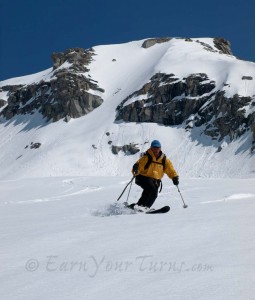
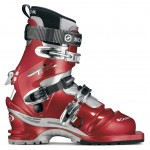
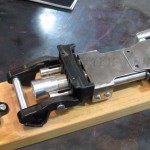
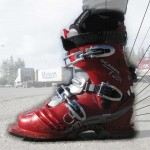
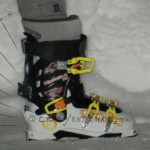
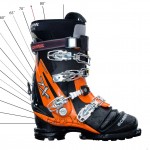
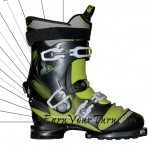
25 comments
1 ping
Skip to comment form
Count me in the waiting for boots with a decent walk mode crowd. I want a stiffer than TX Pro boot with tech fittings and a maestrale like walk mode.
+1. I don’t care about tech toes and shaving weight. As long as weight isn’t added, what I want most is a really soft flexing walk mode that has decent ROM like the TLT series.
.
I asked myself just some weeks ago if i was the only one desperate for these exact changes:
“a tele boot with walk mobility like Maestrale, Dynafit inserts for touring efficiency, their trademark smooth flexing sole, and if you could shave half a pound per boot while you’re at it without compromising anything else, what telemark skier in their right mind wouldn’t upgrade their boots?”
And do not only count american telemark skiers. There’s quite a lot tele-fanatics in europe.
When Scarpa (or Scott or Crispi or BD) starts selling a boot that meets the specs in the quote, i will not hesitate and buy a pair.
Greetings from Bavaria
Good read. I’ve been 100% on tele gear for the last 3 years, but finally replaced my 10 year old DH gear with some armadas and marker barons and might keep using the tele gear to mix it up on lift served terrain, but for BC stuff, the DH setup instills more confidence in tight trees, and works better on mellow slopes than the volkl mantra/22designs AXL/BD Custom tele setup that i’m using now.
Just returned from a week in the cascades at lifts. Very few tele skiers and some days I saw none among thousand of boarders and skiers. Had expected to see a lot more. Wither?…..perhaps and those numbers seem really high.
Watching the tide of interest in Telemark equipment grow and wane over almost 40 years has been an interesting side show for me. Born out of bowling-type shoes on skinny ass cross-country skis whipping out turns the best we could in the 70’s, every new improvement was a welcome one to bring control and to further promote the reason I chose free heel in the first place: the freedom to go where I want, when I want, without any adjustment of my gear whatsoever. Sure, I have spent time on Alpine skis and boarded, but in the end, I have “cheated” on my tele marriage only very rarely over the years. The Pure Freedom that tele guarantees always brought me back rather quickly. Gear will continue to improve whether you are a fan of the NTN (I personally am not, feels like making love with a garden hose on my dick) or the duckbill. It is just a matter of time and investment like most things in this industry. I do support Craig’s call for Scarpa to step up, and they probably will in time. Although the industry big mouths were touting “Tele is Dead” at the latest SIA Snowshow, those of us who have loved, and continue to love the freedom of our tele set ups know it will never, ever, be dead, at least not for us. As for the masses… well, as Craig Dostie said so eloquently earlier this year… “Its OK, not everyone can tele.”
Most of the folks I know purchasing AT set ups right now are still skiing resorts (I’m talking about East coast). They’re using their AT gear to skin up the resort hill and ski down the groomed trail. They’re not in the real BC (yet) or maybe just on occasion. I don’t think they’ll ever go to tele–they’re not into the technique of it, they just want the ability to go up hill. I’ve been on tele gear for five years or so and don’t think I’d go to AT gear–I’m in the tele mindset now ; ). I do one big backcountry hut trip a year in the Selkirks (6 1/2 days of 7-8 hours of touring) and my Scarpa T2s have done the trick. Just switched from 22 Designs’ Hammerhead to G3 Enzo for my new powder skis because it’s way easier to transition between touring/ski mode with the Enzo, but my hammerheads work just fine in the BC of the East. Us tele folks always find each other on the hills–this weekend I skied with folks on NTNs and a guy in leather Lowas on pin bindings he rigged himself (even had done his own paint job on his skis). It takes all kinds, and that’s what I like about tele.
Glad to hear Craig talk about the next gen tele boots. Right now I’m touring exclusively on a TTS/F1 combination (TTS/TX-Pros on the lifts). That combo is lighter than most of the AT systems out there, is proving to be durable and it skis just fine. The TX-Pro/TTS system skis better, of course.
One of the challenges with adding more Range-of-Motion in tele boots seems to be the constraint imposed by the standard heel throw. I think it forces the cuff lock to be much higher than is seen on the modern AT boots. That isn’t an issue with NTN of course. And, one can modify heel throws (as I did) to work on AT boots like the F1. However, that may be a factor that has limited the modernization of ROM in tele boots.
I think the manufacturers’ decision to focus on heavy boots and lift skiers has contributed greatly to the decrease in telemarkers. Without the options for a light, tourable, releasable system, people move to AT. Reasonable weight, releasable bindings are now available and are being refined (NTN, TTS), but the boots remain neanderthal for touring (once you’ve tried something like F1s, TLTs, etc.).
As Craig said, telemark will always be a small market – it always has been. But I would love to see a tech/NTN boot in the 2.0-2.5kg range with large ROM. A ‘TX-0’ that was essentially a lighter, stiffer version of the F1s… Pair that with a TTS binding, perhaps one with an adjustable RV toe and a lighter spring set up.
Until then, buy a pair or two of used, ‘obsolete’ F1s, mount up some TTS bindings and enjoy touring the way it should be! Much like it used to be, actually…
Anyone have a chance to see if the pin crampon attachment points on the new Fritschi/BD Vipec toe could be used to attach a telemark heel (like a TTS system)? They may be too far forward… and perhaps not strong enough… but….? I haven’t seen one in person yet. Perhaps Fritschi/BD have something up its sleeve on that front…
The added plus is the Vipec toe has adjustable release tension.
NTN bindings are heavy, over designed, and contain too many moving pieces that are inherently prone to break. It’s hard to imagine anything more simple, lightweight, reliable and inexpensive than traditional 3-pin bindings. While it’s true 3-pin holes in the duck bill will eventually blowout, this is easily mitigated with simple thin steel plates embedded in the duck bill – I’ve had this custom modification done to both pairs of my plastic telemark boots.
I’m in full agreement about boot manufacturers lagging behind AT in producing a lightweight telemark style touring boot. I currently ski exclusively on Garmont Excursions that are wonderful for walking and for those that have not forgotten how to use wax, to kick and glide with.
Excursions are probably not the best boot for those accustomed to 4-buckle
alpine style boots. But if you grew-up skiing in leather boots and learned to
engage your feet and ankles when making turns, these light and soft plastic
tele boots are the ideal compromise between traditional leather and modern
plastic.
As of last year, unfortunately, Garmont and the Excursions are no more. Hopefully another manufacturer will filled the void. As mentioned in the above post, Scarpa has the know-how.
“In anything at all, perfection is finely attained not when there is no
longer anything to add, but when there is no longer anything to take away, when a body has been stripped down to its nakedness.” – Antoine de Saint
Tele/rando ratio is 1/4 considering an ongoing course in one of the world’s northernmost alpine resort in northern Norway, and I think that’s where the split is here nowadays between these skiing styles. And Norway is outstanding when it comes to the amount of tele among off- and on-piste skiers in Europe.
Long-range skiing is done almost solely on traditional tele equipment, but the shorter trips are made with bigger climbing portion and steeper ascents/descents than before.This makes for fatter skis and lighter/stiffer equipment, and for me the biggest evolution is lightweight plastic AT boots with walking capability compatible with tele ascent (i.e. F1’s) , and TTS-modified Tech-toes mounted on full rocker carbon skis.
Free the heel..
Telemark is a niche. It always has been. When I started 22 years ago it was as a way to get into the backcountry. Back then backcountry skiing was a niche market and there were probably as many AT skiers as Tele skiers. Today the “backcountry” gear portion or the ski market has grown and the sale of AT gear has skyrocketed. Lots of my friends have dropped thier tele gear in favor of AT gear. There are definitely lots more people touring here in the Wasatch these days. However, I still see tele skiers around the resort and a friend was quizzing me on tele gear the other day because he wants to try it out, as a way to learn something new about skiing.
Weather a company wants to keep serving a niche market really depends on thier business model and philosophy. I don’t think the tele portion of the market is dead, by any means. Rather, its merely going through a change.
I liken it to single speed mountain biking. A few years ago there was a surge in the offerings of single speed bikes and components. The devoted said: “I told you it was cool and fun! I’ve known that for years.” The critics said: “Gears rule. It’s more efficient even if it’s heavier. How many times have you seen a single speeder win the overall mountain bike world championship?”
Ultimately, that’s not the point. Single speed bikes teach you how to ride more efficiently and increase your power. They can also wreck your knees and decrease your average cadence which is not as efficient for longer distances.
But… So what? To the devoted they are fun. Same with telemark skiing.
As far as maintaining a good share of a niche market, a manufacturer such as Scarpa can do that with the right products and timing.
As I recall, it was the original terminator that spurred binding development. The boots were ultimately too burly for the crop of bindings that existed at the time. It took a while for binding design to catch up to the boot design. Same is happening now. The NTN and tech fitting equipped boots have some new designs but its a slow process when you have small companies with limited resources doing R&D.
What would be the best measure of participation? Numbers who identify and enthusiasm were mentioned. Amount spent on gear is more easily measured (allowing a discount for gear whores). Hours spent, distance tracked, turns earned and unearned? Number of conversation minutes dealing with the topic, attempts to convert the heathen?
Now that’s a statistic I want more info on, attempts to convert the heathen. Priceless!
Great post Craig, thank you!
I would like to plead the case that Tele is not dying, and
for 75mm to also stay alive and available.
As one of those who was part of the rediscovery of the Tele
turn back in the ‘70’s while teaching Nordic and since then teaching many
hundreds + to Tele I have some opinions to add to this discussion.
I personally got into Tele to get away from where I saw the
Ski business headed in the early 80’s, ie-making rock hard snow, “fixing” the
trails, double fall lines, widening, increasing uphill capacity so trails were
like skiing in rush hour traffic, etc. I was bored w/Alpine, but the Nordic
gear we started on was not beefy enough. Other attributes that early Tele
devotees liked besides it’s backcountry appeal, were the lightness, flexibility
and inexpensiveness of the gear. Due to Tele’s freedom of movement and
lightness of gear I also found freedom from the knee and back pain of being
locked down in Alpine gear 9hrs a day, 6 days a week as a Pro Patroller.
For some time the Tele skiers drove the innovations of the
their sport, then it seemed the business side took over.
As Craig said, the quest to beef up Tele gear “to be on par
w/alpine for downhill prowess” was part of the boom of Tele in the ‘90’s. I
personally believe that having the media hype pick up on it, movies, magazines,
Tele categories for extreme competitions also started appealing to the younger
crowds bringing them into the sport. We have lost this media hype now for some reason. Is it no advertising/sponsor funds?
The frugality and shopping savvy of Tele skiers has sadly
aided in the decline of interest from the business side of the equation. As the
equipment got beefier, so did the prices, putting them on par w/Alpine. This
meant Tele folks deal shopping and retailers struggling to get full retail for
gear, which in turn meant less sales by Reps and their companies. Tele skiers
are a frugal lot NOT a disinterested one. Not sure how to solve this issue and
save those wonderful, local gear head owned shops vs internet.
Companies and shops have to make money to stay in business,
and as AT gear has advanced, Alpine skiers seem to open wallets with more ease for the latest and greatest, so the business end looks to that route. This has meant less money/interest toward new innovations for Tele, which in turn means less advertising, media reviews, and exposure. The cycle makes for a self fulfilling prophecy—generated NOT by skiers, but by business.
The hard part about Tele is that there is no “one size fits
all” equation. NTN may be just the ticket for Big Mountain, hard charging,
steep, firm snow, Avi Terrain, Alpine crossover skiers. It is total overkill
for most of the backcountry low angle woods and meadows of the East at least, if not for all areas where skiers choose to stay out of all Avi terrain if possible.
In my opinion, NNN BC gear does NOT (will not) fill the void
between Nordic, Alpine and beefy Tele set ups, 75mm DOES. Cumbersome AT gear also does not fill the void. I firmly believe that there is still and will
remain a market for the lighter, softer side of Tele as well as the NTN side.
Most of the Tele skiers I know in the East have 2 sets of gear, a soft flexing,
low cuff 75mm boot w/neutral binder that can be used in most BC situations
mainly on some of the new shaped, rockered, waxless skis AND a resort/steeper BC set up. I believe this market exists and will continue as resort skiing and beefy equipment costs go even further through the roof and good snow less reliable. (though the latter I hope gets no worse than this season!) Personally I believe that neither NTN or AT gear currently has a mix of ease of getting around on skis and downhill control combo that 75mm does.
I personally still favor a neutral binding, my choice—G3 Targa, and with them I have not needed the extra weight and moving parts of free pivot for BC. OK— admittedly Old School—but I LOVE that I can direct my equipment rather than having my equipment dictate my style. Sure you NEED a free pivot mode for an active binder, no question! Once again—“one size does not fit all”!!!!!
Speaking of the softer side of Tele—an important component that seems missed by Tele companies, product developers/reps and shops, is that
lighter, shorter, light on their feet style skiers may not need/want taller,
stiffer, “active” 4 buckle boots and bindings. This does not mean these skiers are not aggressive, most just do not have the needed leverage to bend, flex these stiffer bellows, cuffs, tongues, or cartridges.
Another plea for 75mm to remain in the market is in the kids
boot sizes. There are already sadly few shops that can afford the resource
investment of setting up a full size run of kids gear for rental. This is an
area that has been mostly missed by the industry—how to get the youth involved?
I do not have the answer. I have watched many alpine skiing parents take up
tele while their young ones learn to ski so they are learning also. This has
meant that the kids then want to try Tele when feet are big enough for Tele
boots. A rental fleet needs a good selection of kids sizes and if a 3 pin
binding is used it requires far less hassle and amount of skis. I would think
the use of NTN would be cost prohibitive for this.
I am in the business only as a teacher, not a shop owner
etc, it is only slightly that my money is on the table, I LOVE this sport, it
pulls the skiing disciplines together in one set of gear (or 2). I have many
questions, few answers and hopes Tele will live on supported with gear that is
current by both manufacturers and shops.
How do companies/shops afford to keep gear innovations
going, in stock and not take away some of the designs that ARE already working?
How do we get youth involved? Media—why have you dropped Tele? How can we make it “cool” to just go out and ski where it is not life threatening Avi terrain
or guts and glory steeps? Exercise pace now seems to be catching up to the fast pace of life these days—frantic, adrenaline rush being the main goal—OK so maybe my age is showing—but I do believe there are at least 2 sides of Tele
and lots of us do both—so I believe there is and will be a market, maybe not
as huge as some would like, but a niche non the less. Please do not eliminate
75mm lower softer flexing boots, and neutral bindings in the quest to fulfill
the NTN, hard charging, “active” side of Tele.
Two points in reply. First – you completely anticipated my own rebuttal to this article – a defense of the duckbill. You made some great points which only confirms my belief that 75mm tele is hardly dead. Thank you for reinforcing that sentiment. Secondly – WAKE UP and get a free-pivot. Resistance is futile. Free the heel completely for the skin up. A Voile Switchback has the exact same power quotient as the Targa plus the benefit of a free pivot.
Long live the duckbill!
The only time I have thought that maybe a free pivot might be a good idea is when using already made, too steep angle skin tracks. We here in the Eastern woods have lots of things to step over needing to pick up a ski. So you think a Voile Switchback is better than a G3 Targa Ascent if I “Wake up”?
I wouldn’t write off NNN-BC by any means. It’s a simple and strong binding with a natural action (pivot point close to the toes) and good enough to tour and tele on what we now regard as skinny skis. It’s how I learned and on firm snow they’re good for linked teles on blue runs.
Yeah, I do. It doesn’t ice up like the Ascent, is lighter, and switches modes very quickly and reliably – unlike the Ascent. And it really does ski like a Targa – smooth and soft, yet strong enough to hold an edge. One other point. When in free pivot it kicks ‘n’ glides like NNN – very nicely.
Maybe you have the leverage to make the NNN-BC sole flex enough for you, I did not. Size 7.5—wms, found it really tough to feel secure doing turns of any sort. Think the 75mm and 3pin far far superior for skinny skis and narrower BC waxless.
You nailed it. The boots are out there for AT how hard would it be to adapt them to telemark?
DIY bellows? I’d like to see that.
We’re forgetting the kids. That’s where it stays. Ig have a14 year old eager to telly but have no idea what our where to get it. She is a super super super downhill skii
wer recruited by many to race
Not forgotten – overlooked. Garmont developed tele boots exclusively for kids. Essentially it is the Excursion, but in smaller sizes, but they may still not be small enough. It’s called the G-Rex. It isn’t on their website, but it is available. You might need to contact Scott directly. Can’t remember how small they go, maybe mondo 18? or 20?
Well this is a fourteen year old girl so we’re not talking tiny miss shoes but what you’re talking about fit ntn bindings?
[…] Related Posts Review: Factor MX Review: BD Seeker Telemarking: Neither Dead nor Stupid Wither Goest Tele? […]